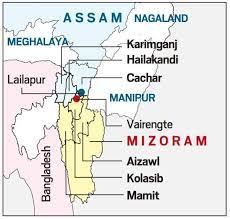Assam-Mizoram border dispute, and its roots
 The recent clashes at the Assam-Mizoram border that resulted in the death of five Assam police personnel on Monday, 26 June, came as a corollary of the long-drawn dissension between the two states over their boundary.
The 164.6 km long border that runs between the two states has again become a flashpoint in the recent years, with several instances of violence being reported in the region.
The conflict-ridden history of this tenuous border, lined by the Barak Valley – Cachar, Hailakandi, and Karimganj on the Assam side, and Kolasib, Aizawl, and Mamit on the Mizoram side, dates back to the Colonial era.
The recent clashes at the Assam-Mizoram border that resulted in the death of five Assam police personnel on Monday, 26 June, came as a corollary of the long-drawn dissension between the two states over their boundary.
The 164.6 km long border that runs between the two states has again become a flashpoint in the recent years, with several instances of violence being reported in the region.
The conflict-ridden history of this tenuous border, lined by the Barak Valley – Cachar, Hailakandi, and Karimganj on the Assam side, and Kolasib, Aizawl, and Mamit on the Mizoram side, dates back to the Colonial era.
-
- The Assam-Mizoram dispute stems from two notifications passed under British era.
- First, notification of 1875, that differentiated Lushai Hills from the plains of Cachar.
- Second, notification of 1933, that demarcates a boundary between Lushai Hills and Manipur.
- Mizoram believes the boundary should be demarcated on the basis of the 1875 notification, which is derived from the Bengal Eastern Frontier Regulation (BEFR) Act, 1873.
- Mizo leaders are against the demarcation notified in 1933, according to them, the Mizo society was not consulted.
- On the other hand, the Assam government follows the 1933 demarcation.
- As a result both states continue to have a differing perception of the border and that is the point of conflict.
- There is a 164.6-km inter-state border that separates Assam and Mizoram, with the three Assam districts of Cachar, Hailakandi and Karimganj sharing a border with Kolasib, Mamit and Aizawl districts of Mizoram.
- Further, the boundary between Mizoram and Assam follows naturally occurring barriers of hills, valleys, rivers and forests, and both sides have attributed border skirmishes to perceptional differences over an imaginary line.
- In the Northeast’s complex boundary equations, clashes between Assam and Mizoram residents are less frequent than they are between other neighbouring states of Assam, like with Nagaland.

- Overall Condition of Inter-State Disputes in India:
- Issue of Boundary: Boundary disputes between the states are one of major reasons for Inter-state disputes in India. For example,
- Karnataka and Maharashtra both lay claim to Belgaum, and every now and then the matter comes up.
- The North-Eastern Areas (Reorganisation) Act, 1971, changed the political map of northeast India, by establishment of the states like Manipur and Tripura and the formation of Meghalaya.
- However, this reorganisation has resulted in many boundary disputes in the northeastern region, like Assam-Nagaland, Assam-Meghalaya, etc.
- Issue of Migration: There have been violent agitations in some states over migrants and job seekers from other states.
- This is because the existing resources and the employment opportunities are not enough to meet the needs of the growing population.
- The ‘sons of the soil’ concept for preference in employment in the states concerned tends to destroy the roots of a healthy federalism.
- Disputes over Sharing Water Resources: The most long standing and contentious inter-state issue has been the sharing of river waters.
- Most of the Indian rivers are inter-state, i.e., they flow through more than one state.
- Due to an increase in demand for water, a number of inter state disputes over sharing river waters have surfaced.
Road ahead
- Boundary disputes between the states can be settled by using satellite mapping of the actual border locations.
- Reviving the Inter-state council can be an option for resolution of an Inter-state dispute.
- Under Article 263 of the Constitution, the Inter-state council is expected to inquire and advise on disputes, discuss subjects common to all states and make recommendations for better policy coordination.
- Similarly, Zonal councils need to be revived to discuss the matters of common concern to states in each zone—matters relating to social and economic planning, border disputes, inter-state transport, etc.
- India is the epitome of unity in diversity. However, in order to strengthen this unity furthermore, both the centre and state governments, need to imbibe the ethos of cooperative federalism.
Next
previous
 The recent clashes at the Assam-Mizoram border that resulted in the death of five Assam police personnel on Monday, 26 June, came as a corollary of the long-drawn dissension between the two states over their boundary.
The 164.6 km long border that runs between the two states has again become a flashpoint in the recent years, with several instances of violence being reported in the region.
The conflict-ridden history of this tenuous border, lined by the Barak Valley – Cachar, Hailakandi, and Karimganj on the Assam side, and Kolasib, Aizawl, and Mamit on the Mizoram side, dates back to the Colonial era.
The recent clashes at the Assam-Mizoram border that resulted in the death of five Assam police personnel on Monday, 26 June, came as a corollary of the long-drawn dissension between the two states over their boundary.
The 164.6 km long border that runs between the two states has again become a flashpoint in the recent years, with several instances of violence being reported in the region.
The conflict-ridden history of this tenuous border, lined by the Barak Valley – Cachar, Hailakandi, and Karimganj on the Assam side, and Kolasib, Aizawl, and Mamit on the Mizoram side, dates back to the Colonial era.










 Latest News
Latest News
 General Studies
General Studies